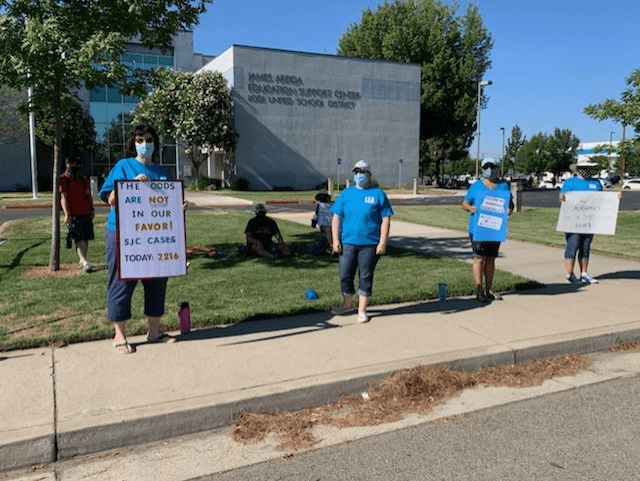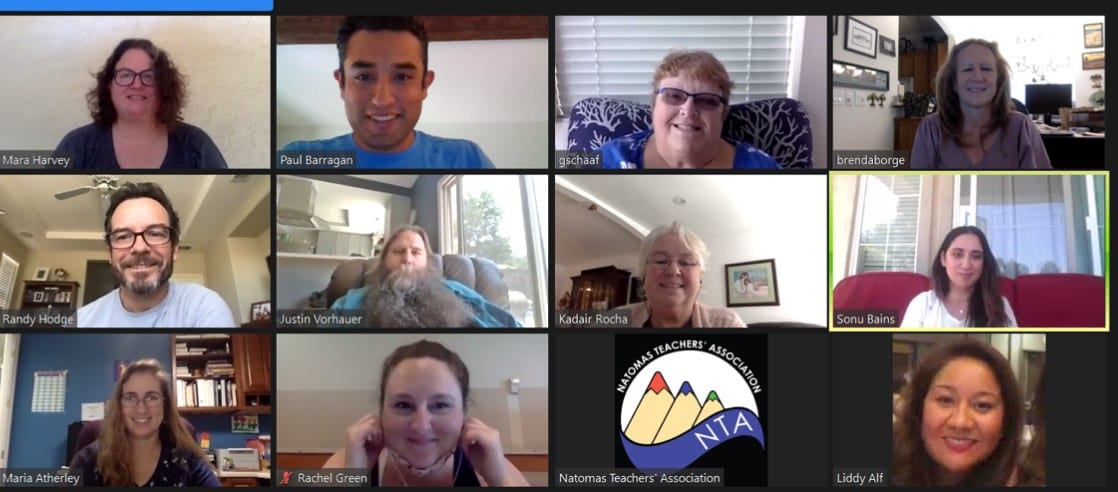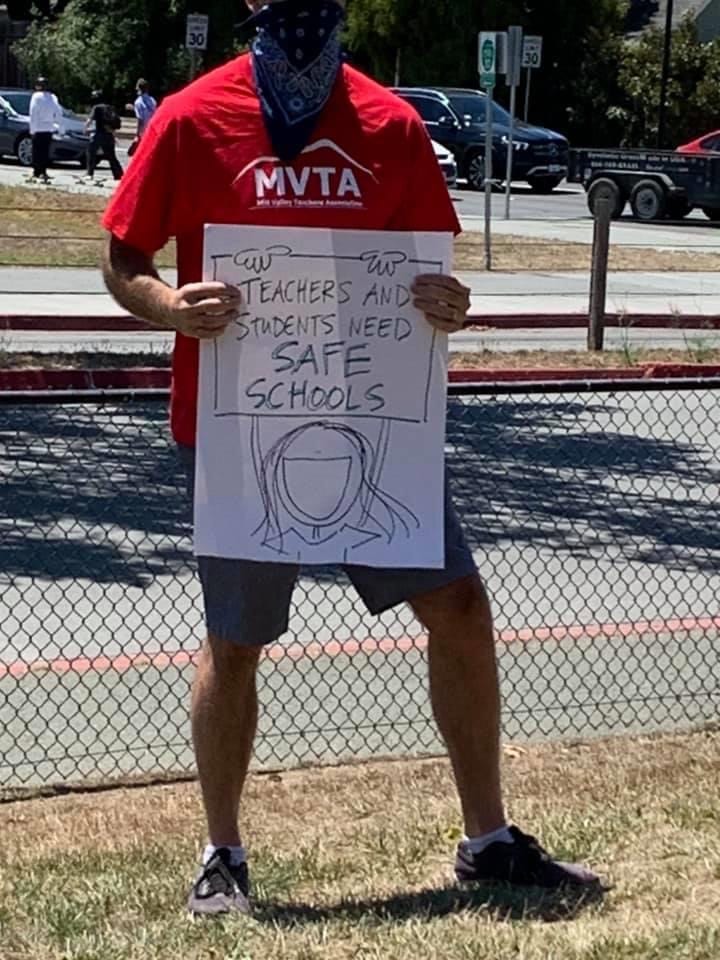What would normally be a time to rest and recharge has been filled with activity for local association leaders across the state standing together for their health and safety as school districts sought to resume in-person instruction despite the growing spread of COVID-19.
With guidance from CTA regarding the safe reopening of schools, locals statewide entered lengthy videoconference negotiations, ranging from collaboration and quick resolution to ensure the health of school communities to weeks of contentious meetings where educators pleaded with school district administrators to acknowledge the pandemic’s threat. In every instance, educators joined their voices to advocate for each other, their students, and the health of their communities.
LODI: Educators organize to win safe options

Lodi educators rally with social distancing to defend their health and safety.
Lodi Education Association members stuck together and rallied for their health and safety, leading to an agreement with Lodi Unified that will allow educators to provide distance learning instruction from their home or school site. Initially, the district sought to require educators to work from school sites, but LEA organized and rallied before a recent school board meeting to show their concern. This display of unity helped move the school board to make the right decision, allowing teachers, coaches, librarians, counselors, speech-language pathologists, psychologists, school nurses and program specialists the option to work from home or at their school site.
NATOMAS: Teachers rally around health issues

Natomas teachers secured safety and teaching provisions.
Natomas Teachers Association negotiated a number of safety and teaching provisions in their COVID-19 agreement with the school district. Their term starts Aug. 27 in a full distance-learning environment. In addition to four additional paid days to prep for distance learning, Natomas teachers secured the option (but not requirement) to work out of their classroom, health safeguards including personal protective equipment and cleaning procedures, and assurances that educators will not be recorded without their permission during class sessions. NTA will negotiate hybrid plans at a later date, based on state and county health guidelines.
LOS ANGELES: UTLA educators win fight for safety
 United Teachers Los Angeles organized and won for the safe and healthy schools that LA students deserve. With COVID-19 cases increasing rapidly in Los Angeles County, UTLA members stood together and convinced the district to start the school year fully in distance learning. A few weeks later, LAUSD agreed to drop its proposal to require educators to teach virtually from their physical classrooms — after UTLA flatly rejected it as unsafe.
United Teachers Los Angeles organized and won for the safe and healthy schools that LA students deserve. With COVID-19 cases increasing rapidly in Los Angeles County, UTLA members stood together and convinced the district to start the school year fully in distance learning. A few weeks later, LAUSD agreed to drop its proposal to require educators to teach virtually from their physical classrooms — after UTLA flatly rejected it as unsafe.
Some key highlights of the memorandum of understanding (MOU) between UTLA and LAUSD: daily live interaction; an average school day from 9 a.m. to 2:15 p.m.; targeted small group instruction, as well as time to focus on social-emotional needs of students; opportunities for ongoing projects, small group work and independent work; office hours where students and families can connect with teachers; and a flexible work schedule for non-classroom educators and early childhood educators to meet the needs of students. A full list is available at utla.net.
“This agreement will be brought to life by educators, students and parents. This MOU is not an end point — it’s a beginning,” says UTLA President Cecily Myart-Cruz. “We must invest more resources to create healthy and safe schools and to build on this MOU with responsiveness to feedback from educators, parents, and students.”
MILL VALLEY: Pushing back to protect teachers and students

Fighting for what’s right.
Mill Valley Teachers Association continues to negotiate details about the start of the new school year at press time. They held a social distancing rally in late July to stand in unity for their students.
MVTA is advocating for strong safety guidelines, a student-centered distance learning plan that reflects best educational practices and recommendations from teacher working groups, and synchronous and asynchronous activities each day to support student learning.
Educators pushed back on the amount of screen time proposed by school district officials (over five hours a day), noting that it is not developmentally appropriate for the K-8 student population.
SWEETWATER: Agreement protects student programs
After nearly two dozen bargaining sessions and a year of negotiations, the Sweetwater Education Association has reached a tentative agreement with the Sweetwater Union High School District. The agreement protects students’ access to vital programs by returning librarians to their sites part-time and reinstating three of the district’s learning centers.
According to SEA President Julie Walker, the agreement was made possible because of the open dialogue between SEA and SUHSD leadership.
“I’m pleased our teams found a path to collaboration and compromise,” she says. “We’ll need that spirit of compromise to face future challenges.”
By turning the focus toward a student-centered approach, the longstanding impasse was resolved. The tentative agreement, which reduces the work year by three days, will be cost-neutral and will allow valuable programs to continue.
SACRAMENTO: Flexibility key to navigating current environment
Sacramento City Teachers Association reached an agreement with school district administration in July that postponed the scheduled early August opening of one of the district’s dependent charter schools. School staff and parents organized to delay the start, and district officials listened, pushing back the opening by a month at New Joseph Bonnheim Community Charter School.
SCTA continued discussions about COVID-related issues, reopening, and working constructively with district officials to implement robust distance learning for all Sacramento City students.